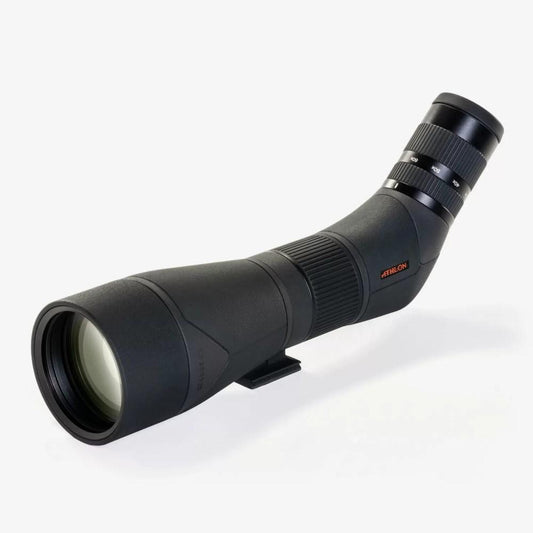

Athlon Cronus G2 UHD Spotting Scope 20-60x86 Black provides a versatile magnification range, allowing you to zoom in from 20x to 60x for detailed observations. Its 86mm objective lens captures bright, clear images even in challenging low-light conditions. This spotting scope features advanced optical coatings that enhance color fidelity and clarity, making it an excellent choice for both birdwatching and hunting. The finely geared focus wheel allows for smooth and precise adjustments, ensuring you can quickly hone in on your subject.
Constructed with rugged aluminum alloy, this scope is built to withstand the rigors of outdoor use. Weighing only 4.5 lbs, it is designed for portability, making it easy to carry on long excursions. Additionally, the waterproof and fog-proof features ensure reliable performance in various weather conditions, giving you the confidence to explore the great outdoors without worry.
Key Features:
- ENHANCED CLARITY for observing wildlife details at dawn and dusk.
- SMOOTH FOCUSING with a finely geared wheel, allowing precise adjustments.
- SUPERIOR LIGHT TRANSMISSION for bright images in low-light conditions.
- IMPROVED COLOR DEFINITION enhances the vibrancy of your viewing experience.
- RUGGED CONSTRUCTION built to endure harsh outdoor environments.
- WIDE MAGNIFICATION RANGE from 20x to 60x for versatile viewing options.
- LIGHTWEIGHT DESIGN makes it easy to carry during outdoor activities.
- WATERPROOF & FOG-PROOF features protect against moisture and fog.
Technical Specifications
| Specification | Details |
|---|---|
| Magnification | 20-60x |
| Lens Diameter | 86mm |
| Weight | 4.5 lbs |
| Dimensions | 15.2 x 5.5 x 5.2 inches |
| Material | Aluminum alloy |
What’s in the Box?
- Lens covers
- Padded case
- Neck strap
Customer Reviews
“An incredible scope! The clarity at a distance is unmatched.” - Sarah H.
“Perfect for birdwatching! I can see details I never noticed before.” - Mark T.
FAQ
How does this scope perform in low-light conditions? The Athlon Cronus G2 excels in low-light with superior light transmission, allowing you to observe your subjects even in dim environments.
Is it waterproof? Yes, it features waterproof and fog-proof capabilities, ensuring your scope remains protected from the elements no matter where your adventures take you.
How heavy is the scope? Weighing approximately 4.5 lbs, it is relatively lightweight given its size, making it easy to transport during long hikes.
Can it be used for digiscoping? Absolutely! The Cronus G2 is compatible with various digiscoping accessories, providing you with even more ways to capture the natural world.
How does it compare to other spotting scopes? The Cronus G2 offers a superior magnification range and enhanced color clarity compared to many competitors in the market, making it a top choice for enthusiasts.
Similar Models
Looking for the perfect binoculars? Discover our extensive Athlon lineup, including models like Athlon Talos 8x42 for versatility and Athlon Midas 10x50 for long-range clarity. Explore our full collection for exceptional optics tailored to your adventures.
You May Also Like
Here’s some of our most similar products people are buying. Click to discover trending style.






